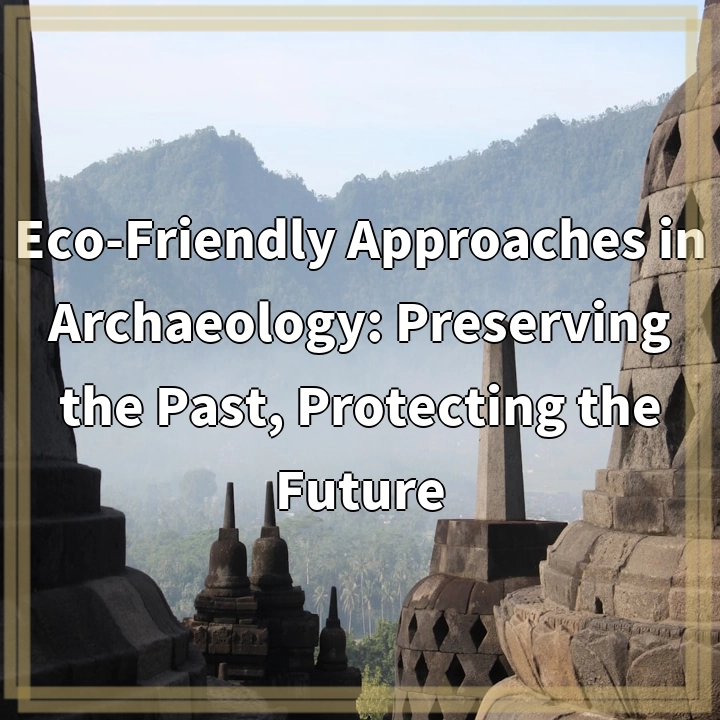Physical Address
304 North Cardinal St.
Dorchester Center, MA 02124
Physical Address
304 North Cardinal St.
Dorchester Center, MA 02124

Eco-friendly approaches in archaeology refer to the use of sustainable and environmentally conscious practices during archaeological excavations, research, and site management. These approaches aim to minimize the ecological impact of archaeological activities while preserving and protecting the cultural heritage and archaeological sites for future generations.
1. Balancing Conservation and Exploration
One of the challenges in eco-friendly archaeology is finding a balance between conserving archaeological sites and conducting necessary excavations and research. Preservation efforts may limit the extent of excavations, making it challenging to gather comprehensive data and understand the full context of a site. Archaeologists must carefully plan and prioritize their efforts to minimize disturbance while still obtaining valuable insights.
2. Mitigating Environmental Footprint
Archaeological activities can have negative environmental impacts such as soil erosion, habitat destruction, and disruption of natural ecosystems. Eco-friendly approaches emphasize the use of low-impact excavation techniques, proper waste management, and minimizing carbon emissions from fieldwork operations. These efforts involve the adoption of sustainable practices, such as using hand tools instead of heavy machinery and implementing erosion control measures.
3. Challenges in Site Management
Ensuring the long-term preservation and maintenance of archaeological sites can be a major challenge. Factors such as climate change, urban development, and inadequate financial resources can put these sites at risk. Eco-friendly approaches in archaeology involve the development of site management plans that take into account the vulnerability of archaeological sites to climate change, as well as the implementation of sustainable infrastructure and ongoing monitoring and maintenance efforts.
4. Public Engagement and Education
To effectively implement eco-friendly approaches in archaeology, it is crucial to engage and educate the public about the importance of preserving our cultural heritage and the role of sustainable practices in achieving this goal. Lack of awareness or understanding among the public and stakeholders about the significance of eco-friendly approaches can hinder conservation efforts. Promoting public outreach initiatives, community involvement, and educational programs can help foster a greater sense of responsibility and ownership.
1. Integrating Conservation and Exploration
Archaeologists can find a balance between conservation and exploration by employing careful planning and prioritization. This includes conducting thorough preliminary research to determine the most valuable and significant areas for excavation, as well as utilizing non-invasive survey techniques whenever possible to minimize disturbance.
2. Implementing Sustainable Excavation Practices
To reduce the environmental footprint of archaeological activities, it is essential to incorporate sustainable excavation techniques. This involves employing hand tools and manual labor instead of heavy machinery, implementing proper waste management protocols, and considering the use of renewable energy sources.
3. Developing Site Management Plans
Ensuring the long-term preservation of archaeological sites relies on the development and implementation of effective site management plans. These plans should include comprehensive monitoring and maintenance strategies to mitigate risks posed by climate change, urban development, and other threats. Sustainable infrastructure solutions, such as low-impact visitor facilities and erosion control measures, should also be considered.
4. Promoting Public Engagement and Awareness
Educating the public and stakeholders about the importance of eco-friendly approaches in archaeology is crucial for garnering support and participation. This can be achieved through public outreach initiatives, community involvement, and educational programs that highlight the significance of preserving cultural heritage and the role each individual can play in sustainable archaeological practices.
Eco-friendly approaches in archaeology prioritize the preservation and protection of cultural heritage and archaeological sites for future generations. Challenges such as balancing conservation and exploration, mitigating the environmental footprint, and addressing site management issues need to be addressed. Solutions involve integrating conservation and exploration, implementing sustainable excavation practices, developing site management plans, and promoting public engagement and awareness.
If you’re wondering where the article came from!
#